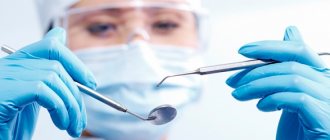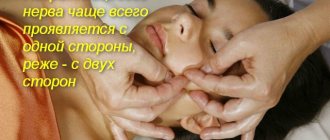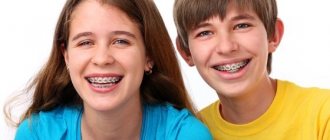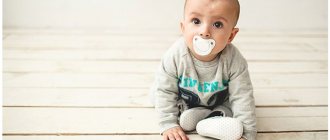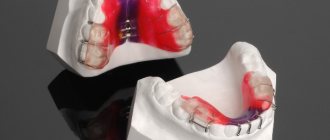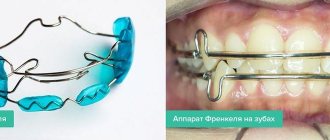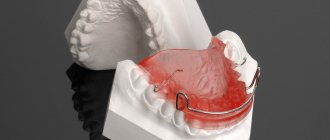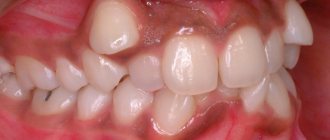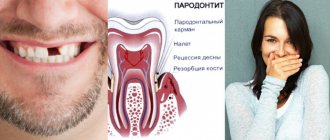8271
Everyone knows the popular wisdom that it is easier to prevent a disease than to treat it later. This statement is more than true when it comes to bite pathologies, the elimination of which is a lengthy process and not always budgetary.
Long-term correction requires patience, food restrictions, and regular medical support. And such devices require more careful care.
Modern designs for aligning the bite make it possible to do this already at the stage of infancy, the main task of which is to diagnose the anomaly in time.
What to do?
An effective treatment method is vestibular plates with a bead or tongue flap, which have been practiced in orthodontics for more than 30 years. This simple but effective device will help eliminate the following problems:
- Many speech defects, some of which are dysarthria and rhinoalia.
- Consequences of bad habits such as thumb sucking and pacifier abuse.
- Anomalies of bite and development of the dental system.
Vestibular plates with a bead for speech defects
At the age of 3-9 years, children develop the habit of a certain articulation when speaking. One of the developmental defects may be dysfunction of soft tissues that are directly involved in articulation. Vestibular plates with a bead for dysarthria help fix the tongue in the correct position. Thanks to the muscle memory of the little patient and the stimulation of the lingual muscle with a bead, the articulation problem will soon be solved.
Another common anomaly of the speech apparatus is rhinoalia. This gives speech a characteristic nasal quality, which is caused by insufficient elevation of the upper palate during phonation. The reason for this is weak articulation, which vestibular plates with a bead will also help to improve. This device can be used during classes with a speech therapist during the correction of hissing sounds and the sound “r”.
One of the common indications for making a vestibular plate is congenital rhinoalia. After surgery to repair a cleft palate, children are prescribed to wear a plate to restore oral sensitivity. This method helps improve tissue tone and train muscles in the oral cavity. Bead plates are also effective in treating stuttering. Massaging the lingual muscle with a bead has a relaxing effect and relieves spasms of the speech apparatus.
Clinical and technical stages of manufacturing vestibular plates.
To take impressions of the jaws, it is better to use alginate impression materials. The impressions should clearly depict the teeth, alveolar processes and the area of the transitional fold of the mucous membrane. The constructive bite is determined by biting on a softened wax roll made on a wax or plastic bite template. In this case, the lower jaw is moved forward and fixed in a position in which the molars are in a neutral relationship. The amount of separation between the dentition should be 2 mm greater than that observed when the lower jaw is at rest. The models are folded taking into account the obtained prints, then plastered in an occluder. The most important next stage in the manufacture of the vestibular plate is the layering of wax on the model. One layer of wax is applied from the distal surface of the last molars of one side to the distal surface of the last molars of the other side; its upper and lower boundaries should extend to the transitional fold of the mucous membrane. The step between the upper and lower incisors, which is due to underdevelopment of the lower jaw and protrusion of the upper incisors, is leveled. The next stage is the layering of a second softened wax plate over the entire vestibular surface of the jaw models, including the alveolar process and teeth, to the highest and lowest located areas of the transitional folds. Consequently, all areas of the vestibular surface of the jaws on their plaster models must be covered with wax; in the lateral areas the layer of wax is thicker than in the front. After this, the wax covering the lower part of the crowns of the vestibularly deviated upper incisors is scraped off, and the cutting edges of the crowns of the upper and lower incisors are exposed. Create a separating layer by smoothing the wax with fingers moistened with liquid soap or soapy water. Then the vestibular surface of the workpiece is compressed with a double plate of wax. The excess is cut off and the labial frenulums are released. After removal from the models, the edges of the wax are rounded and smoothed. The resulting wax mold of the vestibular plate is applied to control models and the accuracy of its manufacture is checked. It should tightly touch the cutting edges and the lower part of the vestibular surface of the crowns of the upper incisors and be spaced from the alveolar processes of the lateral teeth at the distance required to move these teeth and alveolar processes in the vestibular direction. In case of deep incisal overlap, a bite pad is modeled for the lower front teeth. Often, on the outer surface of the wax plate along the line of closure of the lips, the ends of a wire half-ring are placed, which facilitates the insertion and removal of the plate from the oral cavity and allows you to train the orbicularis oris muscle with the help of gymnastic exercises. After this, the plate is plastered into a cuvette, the wax is boiled down, packaged, pressed and the plastic is boiled. Subsequently, the production of the plate is carried out as usual. Children should use vestibular plates mainly during sleep. It must be taken into account that inserting such a plate into the mouth makes mouth breathing impossible. Children who are accustomed to breathing only through their mouths begin to choke. To avoid fright and refusal to use the plate, you should make a hole in it for the passage of an air stream. It should be at the level of the gap between the teeth and lips and have a diameter of 3 to 7 mm. As you master the plate and get used to nasal breathing, this hole is reduced and then closed with self-hardening plastic. When breathing through the mouth, the tongue falls to the bottom of the mouth; its root is usually displaced back. In the process of using the vestibular plate, the position of the tongue is normalized, as a result of which it fills the arch of the palate and puts pressure on the lingual surfaces of the lateral teeth, which contributes to the expansion of the upper dentition. As a result of the contact of the plate with the vestibularly deviated upper incisors, under the influence of the force of contraction of the labial muscles, their retrusion occurs. As the incisors move in the palatal direction, the plate also gradually moves back and approaches the mucous membrane of the gums and alveolar process. The appearance of additional contacts prevents further retrusion of the upper incisors, expansion of the upper dental arch and forward movement of the lower jaw. At this stage of treatment, alteration of the device or its correction with self-hardening plastic is indicated. Liquid-mixed self-hardening plastic is applied to the recesses at the point of contact of the vestibular plate with the upper incisors. In this case, you should hold the plate in your hands so that the imprints of the cutting edges of the upper incisors are directed upward - this prevents the plastic from running off. After the plastic has thickened somewhat, the device is inserted into the oral cavity and lightly pressed against the teeth to obtain slightly pronounced imprints of the most prominent incisors. This correction can be repeated during treatment. The vestibular plate can correct the vestibular deviation of the incisors and stimulate the growth of the lower jaw. With its movements, the pressure of the lower lip on the plate increases, and through it - on the upper incisors. Unpleasant sensations force the child to protrude the lower jaw, which promotes its growth and enlargement of the oral cavity. Orthodontic treatment is more effective when combined with exercises during the day. Gymnastic exercises involve the child inserting a vestibular plate into the mouth and pulling it forward, placing the thumb in a wire ring. In this case, the lips are compressed to hold the plate in the mouth. Repeated repetition of the exercise improves lip closure. To increase the pressure of the apparatus on the upper front teeth, F. Ya. Khoroshilkina modified the vestibular plate with a bite platform for the lower incisors by attaching a face bow to it. Using a rubber traction from the ends of the face bow to the hooks on the head cap or neck bandage, pressure is exerted on the upper front teeth , which accelerates their establishment in the dentition. In addition, the vestibular plate with extraoral traction is better retained in the oral cavity and is more quickly mastered by the child (Fig. 16.3).
Rice. 16.3. A combination of functional devices with extraoral traction (according to Khoroshilkina). 1 - with the vestibular plate; 2 — with Muehlemann propulsor; 3 - with Frenkel function regulator; 4 - with open Klammt activator; 5 - with Andresen-Heupl activator; 6 - with Bimler bite former.
Vestibular plate with wire tongue flap for malocclusion
To correct malocclusions, a vestibular plate with a tongue flap is often prescribed. It helps correct problems that are congenital or caused by a number of bad habits. This type of orthodontic plate allows you to control the position of the tongue in the oral cavity when pronouncing certain sounds. The inability to produce interdental sounds may be a consequence of an open bite. A vestibular plate with a flap will help correct an open bite in the shortest possible time. The device is held in the mouth using the lip closure reflex, which is established within 2 hours of wearing the plate per day.
Orthodontic vestibular plates MUPPY
One of the mildest ways to treat dental anomalies in children is the MUPPY orthodontic vestibular plates. High-quality materials do not cause oral allergies in children. The MUPPY vestibular plate with a bead is one of the most common choices of parents who care about the dental health and future beautiful and literate speech of their children. German manufacturer Dr. Hinz Dental makes the best instruments for painless prevention of dental deformation.
Timely help for a child
The use of special vestibular plates is usually prescribed to children aged three to nine years when they develop a primary or mixed bite (and if aligners and trainers
won't help anymore).
The reasons for the need to use a plate are mainly speech problems caused by dysfunction of soft tissues - constant participants in articulation. With the help of vestibular plates, you can, as they say, launch the self-regulating functions of the child’s body. Vestibular plates Dr. Hinz Dental
Bad habits leading to dental anomalies
Having noticed a malocclusion or a speech problem in a child, parents should first try to understand the cause of the pathology. The most common cause of dental deformation is bad habits, such as pacifier abuse. A vestibular plate with a bead will also help here, reviews of which are almost always positive. The fact is that with prolonged use of the pacifier, the reverse type of swallowing is maintained, when the tongue rests on the front incisors. Pressure on the teeth as the jaw forms can cause protrusion—the forward movement of the lower jaw. Therefore, it is recommended that your child be weaned off pacifiers before reaching 3 years of age.
Another common bad habit that parents of toddlers may observe is thumb sucking. You need to pay special attention to this reflex after giving up the pacifier. This habit can lead to the development of an asymmetrical bite. With this defect, the upper incisors protrude noticeably forward. The MUPPY vestibular plate with a bead, about which you can hear only positive reviews from many patients, will help correct these defects.
General overview
The vestibular plate is an orthodontic product with a preventive spectrum of action.
The technique is recommended for use in early childhood if the child has bad habits that can play the role of a provoking factor in the development of malocclusion pathologies.
To wean a child, say, from thumb sucking, and to switch his attention to another object, specially designed plates are used as an alternative. Thanks to periodic exposure to the device, the defect is treated naturally.
Problems that can be solved by using the MUPPY vestibular plate
- Mouth breathing is one of the problems for which an orthodontic plate may also be prescribed. By reflexively closing the lips while wearing the plate, uniform nasal breathing is normalized. Contraindications to this method may include sinusitis and chronic rhinitis.
- Normal development of the lower jaw is not always possible without the help of orthodontic methods. Wearing a vestibular plate normalizes jaw development and contributes to the formation of a beautiful and even bite.
- An orthodontic vestibular plate will gently eliminate speech defects in less than 3 months.
- Infantile swallowing is one of the common causes of open bite. The plate will help normalize the position of the tongue and avoid the development of protrusion.
- When wearing an orthodontic plate, natural self-regulation processes are established, which can be inhibited for various reasons.
When using MUPPY plates, you can easily and without coercion get rid of bad habits. This method can be an indispensable assistant in the process of giving up pacifiers. At this difficult moment for the baby, the plate will relieve discomfort and stress. One of the problems with plate treatment is the wearing schedule. Children may experience some discomfort that the vestibular plate with bead may cause when worn at night. In St. Petersburg, many orthodontists recommend starting treatment gently, with the help of games. The time of wearing the MUPPY plate increases gradually, which does not cause stress or rejection in the baby.
How to place a plate on a child’s teeth?
The dental plate is not suitable for adult patients. This is an exclusively children's orthodontic device. First of all, plates for straightening teeth in children are used up to 12 years of age. During this period, there is active growth of the jaws, which makes it possible to quite effectively correct the bite, eliminate crowding and remove other occlusion anomalies.
When the jaw bones have formed, it is only possible to align the teeth within the dentition. And correction of bite in adult patients is only possible with the help of braces and orthognathic surgery. In this regard, parents should not delay visiting a specialist, even if it is a preventative one, if treatment is not required. Orthodontists recommend placing a plate on a child’s teeth to achieve the following treatment goals:
- correction of jaw shape;
- regulation of jaw growth;
- correct placement of incisors in a row;
- increasing or decreasing the size of the sky.
Installing plates on children's teeth usually takes several weeks, since they are made individually for each patient. To create a suitable orthodontic appliance, the patient undergoes an X-ray examination, then the doctor takes an impression of the teeth for the plate. After this, plaster models are made, from which the structures are created.
Child malocclusion is a common problem that many parents have to deal with. There can be many reasons:
DETAILS: Correcting crooked teeth - effective ways to correct crooked teeth
- small jaw size inherited from parents;
- baby teeth had to be removed ahead of time because caries was developing quickly and the damaged teeth could not be saved;
- bad habits - the baby sucks his finger or bites his lip;
- the child often (more than 2-3 times a year) gets sick and is forced to breathe through his mouth because his nose is blocked;
- teething occurs faster than the jaw grows.
The child definitely needs preventive examinations from the orthodontist in order to cope with malocclusion at the initial stage, when the front permanent teeth erupt, and while this is still easy to solve. To correct the bite during jaw growth, orthodontists use removable plates.
Types of vestibular plates MUPPY
A specific vestibular plate with a bead can be selected for each patient. Instructions for its use are issued by the doctor and are included with the kit. Manufacturer Dr. Hinz Dental offers the following types of plates to help solve individual problems of dental and speech anomalies:
- MUPPY-S – to restore nasal breathing and eliminate the habit of thumb sucking.
- MUPPY-OS – to eliminate protrusion and retrusion.
- MUPPY-G – to eliminate dysfunction of swallowing and speech.
- MUPPY-P – for tongue massage.
As practice shows, it is the vestibular plate with a bead that helps solve many problems quite easily and safely at an early age. Instructions for each of them are included in the kit and will help everyone understand the basic principles of its use.
Myofunctional trainers for teeth MRC
MRC myofunctional dental trainers are produced by the well-known company Myofunctional Research Co. Most often, dental trainers are used for disorders of the muscles associated with breathing, chewing, swallowing and speech. In addition, dental trainers can help a child with bruxism (note, this problem goes beyond just a dental approach; consultation with an osteopath and a child psychologist is required). There are special trainers for teeth with braces that enhance the effect of treatment and protect the soft tissues of the oral cavity. Acting physiologically and effectively, dental trainers eliminate the root of the problem, and not just its manifestations. Used in children from 2 to 15 years old.
